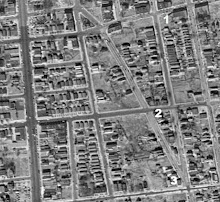While Brooklyn was developing as a center of commerce and industry Southern Brooklyn wasn't sitting quietly letting the rest of the world go by. Especially so in Gravesend. Thrusting itself against the Atlantic Ocean its location was natural for development. The industrial revolution played a great role in its rise to prominence, as did the rise of the moneyed class in New York and Brooklyn. And greed, corrupt politics and vice played significant roles as well.
Walt Whitman discovered Coney Island at a time when it was dismissed by most local residents as a mucky mess. It's relative remoteness and quietude was a most desired quality making it a excellent location for solitary reflection. Away from the bustle of the developing cities of Brooklyn and New York where he worked and lived he could replenish his creative energies here. Perhaps he recited some of his early poems to an audience of local rabbits.
Coney Island House opened in 1829. Eventually it became a destination for the privileged classes. But the main road to Coney Island was a shell road. Of course one could also get there by water. Such was the method used by gamblers and other "undesirables". It is said that the moneyed classes who came to the island often became the prey of these various criminal types. I do rather suspect that the historians have engaged in a bit of overstatement about their effect upon the visiting.
In the 1840s the village of Sheepshead Bay , then known as The Cove, started, most of the original dwellings were in the vicinity of what is now East 23rd Street south of Voorhies Avenue. The well-to-do would lay claim to this area as well for a time. Many would eventually build homes here, causing Voorhies Avenue to become known as "Millionaire's Row".
In 1850 a plank road was built along the route of what is now Coney Island Avenue. This road led to the development of the eastern section of Coney Island, and the better classes of visitors started migrating towards this area. Hotels were built and the Island grew in importance as a resort. Numerous people made their fortunes in part from the increasing popularity of the area. Racetracks were built, and early signs of its later role as an amusement area manifested itself. And a local carpenter, an Irish immigrant named John McKane played a large role in making Coney Island, and Gravesend itself nationally known both as a resort and as a haven for all manner of criminals. We shall discuss John Y McKane further in our next installment.
Walt Whitman discovered Coney Island at a time when it was dismissed by most local residents as a mucky mess. It's relative remoteness and quietude was a most desired quality making it a excellent location for solitary reflection. Away from the bustle of the developing cities of Brooklyn and New York where he worked and lived he could replenish his creative energies here. Perhaps he recited some of his early poems to an audience of local rabbits.
Coney Island House opened in 1829. Eventually it became a destination for the privileged classes. But the main road to Coney Island was a shell road. Of course one could also get there by water. Such was the method used by gamblers and other "undesirables". It is said that the moneyed classes who came to the island often became the prey of these various criminal types. I do rather suspect that the historians have engaged in a bit of overstatement about their effect upon the visiting.
In the 1840s the village of Sheepshead Bay , then known as The Cove, started, most of the original dwellings were in the vicinity of what is now East 23rd Street south of Voorhies Avenue. The well-to-do would lay claim to this area as well for a time. Many would eventually build homes here, causing Voorhies Avenue to become known as "Millionaire's Row".
In 1850 a plank road was built along the route of what is now Coney Island Avenue. This road led to the development of the eastern section of Coney Island, and the better classes of visitors started migrating towards this area. Hotels were built and the Island grew in importance as a resort. Numerous people made their fortunes in part from the increasing popularity of the area. Racetracks were built, and early signs of its later role as an amusement area manifested itself. And a local carpenter, an Irish immigrant named John McKane played a large role in making Coney Island, and Gravesend itself nationally known both as a resort and as a haven for all manner of criminals. We shall discuss John Y McKane further in our next installment.

No comments:
Post a Comment